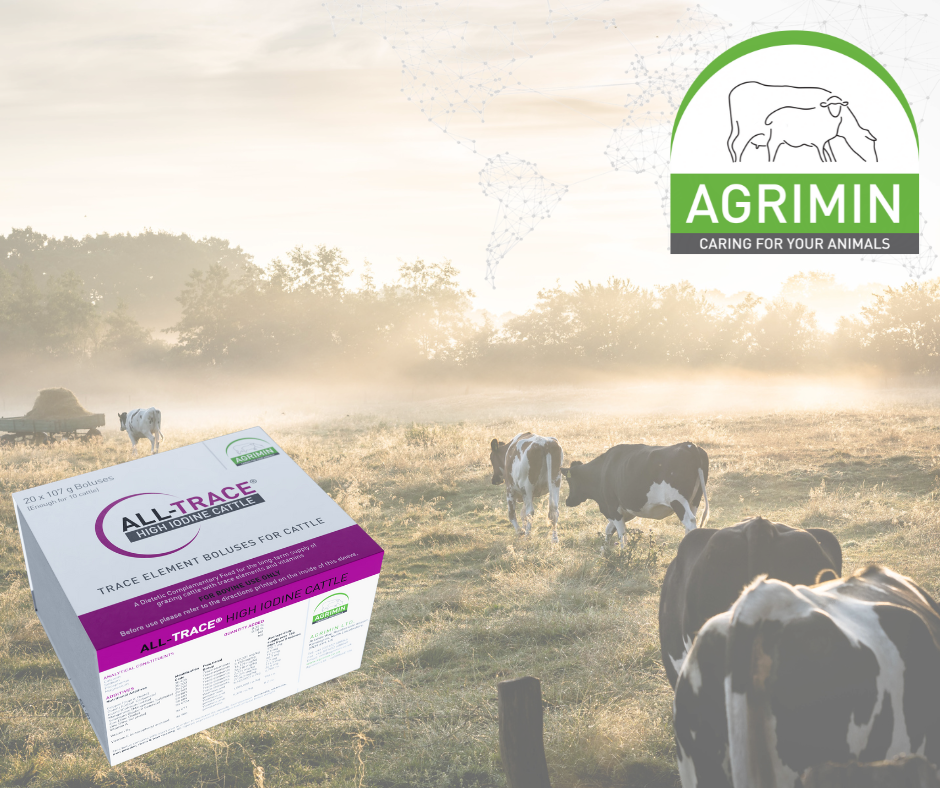Tel: +44 (0)1652 688046 | E: [email protected]
Iodine Shortfall in Cattle - Symptoms & Supplements Explored

A shortfall in iodine in cattle can have costly consequences for farmers and, all too often, when you realise there is a shortfall, it has already had an impact on productivity.
So how do farmers tell if there is a shortfall of iodine in their cattle? How do they overcome a shortfall of iodine in cows and, what is the most effective way of supplementing iodine in their cattle?
In this blog we explore the role of iodine in cattle, the sources of iodine, the challenges of testing iodine levels in cows, the critical moments when cattle need iodine the most, and what farmers must do to make sure they are optimising the performance of their cattle.
What Causes an Iodine Shortfall?
A shortfall of iodine is not a clinical condition and a shortfall can happen for a variety of reasons. The key challenge is that iodine is poorly stored in the animal, unlike many other animals.
This means they need a constant supply of iodine to prevent any health complications and, in many instances, it is very difficult to supply all of the iodine cattle need from the diet alone. For most farmers, their soil will be low in iodine and this means grazing and forage could be lacking in this key element.
Adding iodine to the soil also has little value as plants are slow to uptake the mineral and it will have no significant benefit to the animal.
Another issue is that some feeds, such as brassicas and legumes, can also negatively impact iodine levels in livestock and this also needs to be taken into consideration. These goitrogenic feeds actively inhibit iodine uptake from the gut and will result in a need for an increased iodine requirement.
Winter also places an increased demand for iodine and farmers must take these different factors into consideration when working to prevent a shortfall.
Iodine is key because it is used in thyroid gland to produce the hormones that drive metabolism and support growth. A shortfall in breeding animals can affect fertility and can result in stillborn or weak calves if the mother doesn’t have the right supply in mid-late pregnancy.
How Do You Test for a Shortfall in Iodine?
A shortfall will impact the thyroid in the cow and it is a difficult element to test for in determining its status, making it one of the hardest elements to manage.
There are a couple of tests that farmers can undertake to measure iodine levels but both present problems.
You can test for thyroxine (T4), the storage thyroid hormone, but the results can be challenging for a layman to interpret, and are affected by lactation, energy status and disease.
The most commonly used test is to check the plasma inorganic iodine (PII) levels, but this can be very expensive and it only shows the iodine intake at that moment. The challenge is that this test is highly responsive to the iodine intake around the time it was taken and it may not present an accurate overall picture.
What Are the Symptoms of an Iodine Shortfall?
The challenge for farmers is that it is almost impossible to spot signs of a shortfall in iodine deficiency in adult cattle until it is too late.
The reality is that most farmers will only realise they have a shortfall of iodine when they get a dead calf, or if they have calves that are slow to get up and suckle or have poor vitality.
A post-mortem on a dead calf that is deficient in iodine will often reveal an enlarged thyroid gland..
One of the big issues is that, in the final stages of gestation, the demand for iodine is accelerated – the calf is growing rapidly, and the udders are preparing for milking.
This is a perfect storm, and the animal can’t always work through the final stages of gestation and still provide the iodine the calf needs, resulting in stillbirths, calves dying soon after calving, or calves with poor vitality. Further, if the cow remains in a low iodine state, the colostrum and milk can be low in iodine and therefore not adequately supplement the calf and help it to recover.
How Can a Shortfall in Iodine Be Overcome in Cows?
The solution to managing a shortfall in iodine is to take preventative action by providing cattle with an iodine supplement. And the simplest way to supplement iodine is with a bolus.
A bolus provides a predictable and controlled release of iodine over a set period of time, and this corrects any shortfall while providing the security a farmer needs to know that any potential issue has been addressed.
Using this method, a bolus is administered to the animal, and it then lies in the reticulum where it will slowly erode and eventually disappear completely, providing a continuous and regular supply of nutrients to the animal.
There are other methods of supplementing iodine but none provide the same assurance that the cow is getting everything they need. For example, some farmers may opt for an iodine drench and this provides a quick boost of the element but, as we’ve already said, iodine is then poorly stored in the animal.
If you would like to know more about how to manage iodine in your cattle or have any questions about supplementation, please do not hesitate to get in touch at [email protected]
© Agrimin Ltd. Privacy Policy | Translation Disclaimer. Designed by www.edgeinteractive.org.uk




